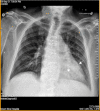Community-Acquired Acinetobacter radioresistens Bacteremia in an Immunocompetent Host
- PMID: 36321031
- PMCID: PMC9612910
- DOI: 10.7759/cureus.29650
Community-Acquired Acinetobacter radioresistens Bacteremia in an Immunocompetent Host
Abstract
Acinetobacter species are gram-negative coccobacilli ubiquitous in nature and widely distributed in the environment. Acinetobacter baumannii is a bacteria commonly seen in the hospital setting, responsible for causing a wide range of bloodstream infections, urinary tract infections, secondary meningitis, infective endocarditis, and wound infections, and is the cause of outbreaks mainly due to its antimicrobial resistance patterns. The use of broad-spectrum antibiotic coverage with carbapenems is essential in the hospital setting. Therefore, carbapenem-resistant Acinetobacter baumannii (CRAB) poses as a very challenging pathogen. Acinetobacter radioresistens, a rare species in comparison to the more prevalent Acinetobacter baumannii, is an underestimated agent in causing nosocomial infections and also is a potential disseminator of resistance genes. It is also resistant to gamma radiation at 4-8 times higher than other Acinetobacter spp. and is the source of the class D OXA-23 carbapenemase that can confer carbapenem resistance. Therefore, immediate and precise identification of A. radioresistens is crucial for the clinical management of multidrug-resistant bacteremia.
Keywords: acinetobacter; acinetobacter baumannii; acinetobacter radioresistens; bacteremia; bacteremia in immune-competent individuals; carbapenem resistance; carbapenemase; maldi-tof; multidrug-resistant acinetobacter; pneumonia.
Copyright © 2022, Lazarev et al.
Conflict of interest statement
The authors have declared that no competing interests exist.
Figures
References
-
- An increasing threat in hospitals: multidrug-resistant Acinetobacter baumannii. Dijkshoorn L, Nemec A, Seifert H. https://doi.org/10.1038/nrmicro1789. Nat Rev Microbiol. 2007;5:939–951. - PubMed
-
- Acinetobacter radioresistens as a silent source of carbapenem resistance for Acinetobacter spp. Poirel L, Figueiredo S, Cattoir V, Carattoli A, Nordmann P. https://doi.org/10.1128/aac.01304-07. Antimicrob Agents Chemother. 2008;52:1252–1256. - PMC - PubMed
-
- Taxonomy of the genus Acinetobacter with the recognition of Acinetobacter baumannii sp. nov., Acinetobacter haemolyticus sp. nov., Acinetobacter johnsonii sp. nov., and Acinetobacter junii sp. nov. and emended descriptions of Acinetobacter calcoaceticus and Acinetobacter lwoffii. Bouvet PJ, Grimont PA. Int J Syst Evol Microbiol. 1986;36:228–240.
-
- Distribution of Acinetobacter species on skin of healthy humans. Berlau J, Aucken H, Malnick H, Pitt T. https://link.springer.com/article/10.1007/s100960050254. Eur J Clin Microbiol Infect Dis. 1999;18:179–183. - PubMed
-
- Acinetobacter radioresistens infection with bacteremia and pneumonia. Wang T, Costa V, Jenkins SG, Hartman BJ, Westblade LF. https://doi.org/10.1016/j.idcr.2019.e00495 IDCases. 2019;15:0. - PMC - PubMed
Publication types
LinkOut - more resources
Full Text Sources
Miscellaneous


